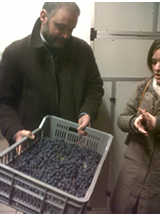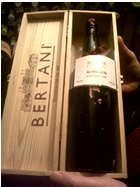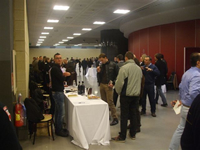 |
Federico Pellizzari of Terre
Di Leone explaining grape
drying process
|
The Valpolicella produces a wide range of delicious wines ranging from lighter reds to more intense ones such as Ripasso and Amarone, made from air-dried grapes. The region has seen a continued increase in quality over the past few decades, visible in the wines of both traditional estates and small innovative producers.’
Those are the factors cited by the Wine Enthusiast magazine to select Valpolicella, near Verona in the Italian region of Veneto for the prestigious ‘Wine Region of the Year 2009’ award ‘for the quintessential wines, Amarone and Ripasso, its commitment to tradition and for the unique approach it takes to all its wines.’
The other four wine regions competing for the honour- Champagne, Rhone Valley, Russian River Valley in California and Stellenbosch in South Africa, make the recognition well deserved, says Luca Sartori, President of the Consorzio Tutela Vini Valpolicella.
Valpolicella has been quite a popular wine since the pizzas and pastas entered the metros as the casual Italian cuisine in India about 15 years ago. But Ripasso and Recioto wines are still quite unheard of, with Amarone earning the respect of wine enthusiasts as a well-known Italian wine, beyond the budget of most connoisseurs due to heavy duties and the heavier profit margins of the hotels purchasing them without any customs duty.
Conception by accidence
The three grapes used for making most of red wines of Valpolicella are Corvina and its family grape Corvinone, Rondinella and Molinara though other indigenous grapes like Oseleta are also used in small quantities and recently a small proportion of international varieties has also been allowed. Besides the basic quaffable Valpolicella which in the classic region that includes Negrar, Fumane, Sant’Ambrogio, Marano and S. Pietro in Cariano is known as Valpolicella Classico, there are three other wines, Recioto, Valpolicella Ripasso and Amarone made from the same grapes but by air-drying grapes for about 4 months and then slow fermenting in the tank.
When the fermentation of the dried grapes concentrated with sugar is stopped midway, leaving the alcohol level low but sugar content high, it is known as the famous Recioto di Valpolicella -minimum sugar level prescribed by the DOC laws is 54 gms per liter ( ordinarily the dry red Valpolicella DOC has less than 5gms.-typically 2-3 gms.). However, most Reciotos tasted had sugar level of 80-100 gms per liter.
Whereas the other noble wines of Italy-Barolo, Barbaresco and Brunello are known to have been made over a century ago and Recioto has been the classic wine of the region, Amarone was conceived by accident in 1938. Says Luca Bissoli, export manager of the co-operative Cantina Valpolicella Negrar (new name of Cantina Sociale di Valpolicella since I last visited it ), ‘Gaetano Dall’Ora, one of our founders tasted a vat of Recioto our cellar master had left by mistake without racking it, causing all the sugar to ferment. This resulted in a dry, robust and fleshy wine full of flavours and yet elegant.’ This was later to be named Amarone- big and bitter in Italian language.
There might also be similar legends told by other wineries making recioto at that time but it was not until 1939 that Amarone was recognised as a unique and different wine. It got the DOC recognition later.
Elegant, Evolved but Expensive
Antica Bottega del Vino in the heart of Verona is one of the top enoteca- cum-restaurants of Italy. ‘It is rated as one of the 80 Grand Awards Restaurants named by the Wine Spectator’, said Severino Barzan, the owner whom I had earlier met at the Davos of Wine event in Villa d’Este last October and who had just returned from New York where he also owns a branch of the popular restaurant in Manhattan, when I met him at the Bottega.
The most expensive wine in his cellar in Verona currently valued at over 3 million Euros, and which stores top chateau wines from Bordeaux, Burgundy and top wineries in the rest of the world is an Acinatico 1928 from Bertani (one of the 7 founding members of the Co-operative and which was recently bought over from GIV by Lunelli of Ferrari, the sparkling wine producer from Trentino). Priced at € 9,800 a bottle (Rs. 640,000) it is the sweet pedigreed wine of Valpolicella like a Recioto, produced when there were no appellation laws. wineries in the rest of the world is an Acinatico 1928 from Bertani (one of the 7 founding members of the Co-operative and which was recently bought over from GIV by Lunelli of Ferrari, the sparkling wine producer from Trentino). Priced at € 9,800 a bottle (Rs. 640,000) it is the sweet pedigreed wine of Valpolicella like a Recioto, produced when there were no appellation laws.
The Amarone has been evolving constantly since 1939 and the elegance and power-due to the higher sugar concentration of the dried grapes achieved by reduction of water content by 30-40%, has attracted many wine lovers from across the world making the demand and prices go up but production going up even higher.
Too much Greed …
It happened to Rioja; it happened to Mosel, it happened to Marlborough. Therefore, it is not surprising to see it happen to Amarone as well. The appellation rules allowed up to 70% grapes to be used in Amarone. Against an estimated demand of 9 million bottles, the production touched 15 million bottles in 2008 without a corresponding increase in demand thus resulting a decrease in prices and increase in inventory, ringing the warning bells and making the consortium step in and reducing the grapes allowed to make Amarone to a maximum of 50%. This step did help bringing down the production to 12 m bottles last year and helping the quality gets better at the same time, due to lower yield.
With an increasing pressure on the prices and reduction of demand at higher prices, there was a better balance and last year about 9 million certification stickers were issued in toto by the Consorzio.
…And Alcohol
The slow fermentation of concentrated grapes means full conversion to alcohol of the higher sugar contents means and this implies wine with higher level of alcohol. Starting from 14.5% generally, the levels go up to 16% and even 16.5%, making Amarone a full body, high alcohol wine even when well integrated, making it suitable with red meats and game. Its elegance despite heavy alcohol has made many people refer to this wine as a meditation wine.
Status Elevated
While Barolo, Barbaresco and Brunello have enjoyed the status of DOCG for several years, it was only late last year that the Amarone was granted the elevated status to be effective from 2010. The notification also calls for tightening the production rules, including the condition that the wine must be bottled in the appellation area-of grape production.
The wine popularity has also resulted in fake wines being produced and last year a fraud involving a million bottles and a Danish supermarket chain was uncovered . The DOCG regulations are further meant to tighten up the production norms. This should help in controlling the frauds.
Incidentally the Recioto di Valpolicella has also been accorded the DOCG status while Ripasso di Valpolicella which is made by passing the Valpolicella wine over the skins of Amarone gets the Ripasso DOC status without having to hide behind the skirt of Valpolicella- thus labelled currently as Ripasso della Valpolicella
Amarone, Amarone Everywhere
 Quintarelli, Romano Dal Forno, Allegrini and Masi are a few of the quality producers known internationally. But so are Speri, Santi and Sartori whose wines it was a pleasure to taste. It may be confusing to know the difference between Tedeschi, Trabucchi or Tomassi for a first timer but an equal fun can be relating to different styles of Amarone from Zeni or Zenato which incidentally have been present at Vinitaly India and are good producers to have a representation. Quintarelli, Romano Dal Forno, Allegrini and Masi are a few of the quality producers known internationally. But so are Speri, Santi and Sartori whose wines it was a pleasure to taste. It may be confusing to know the difference between Tedeschi, Trabucchi or Tomassi for a first timer but an equal fun can be relating to different styles of Amarone from Zeni or Zenato which incidentally have been present at Vinitaly India and are good producers to have a representation.
Who does one prefer- Igino Accordini or Stefano Accordini. But wait, isn’t Daniele Accordini the winemaker at the Cantina Valpolicella Negrar? And didn’t Tiziano Accordini at Stefano Accordini say his brother Daniele helps him in winemaking. Is Marco Campagnola of San Rustico related to the Giuseppe Campagnola family? Have you tried Musella? Yes, but I liked Manara better. Did you visit Fabiano? No, our group went to Farina. Are you visiting Tinazzi or Tezza? No, our group visits Terre di Leone… Many wineries, more comments resulting in more questions! But there is always as much buzz about the different and diverse wineries as of Amarone.
There are as many styles of Amarone as the producers some of whom are related directly or through marriage, making the mosaic extremely interesting and tasting Amarone 2006 a pleasure- from the 65 producers who had taken part in the once-in-a year event that was as exciting as the wine itself, making the amore for Amarone grow more than ever.
Subhash Arora
Visit to the wineries featured in a future edition of delWine-editor
Comments: |
|
Faye Cardwell - IEM Says: |
|
Nice read. Liked the bit about the names – you’re right, for a non Italian speaker can be a nightmare with them all being so similar! Keep up the good work! Faye |
|
|
|
| |
|